seats PORSCHE CAYNNE TURBO 2005 1.G Owners Manual
[x] Cancel search | Manufacturer: PORSCHE, Model Year: 2005, Model line: CAYENNE TURBO, Model: PORSCHE CAYENNE TURBO 2005 1.GPages: 369, PDF Size: 3.17 MB
Page 11 of 369

Controls, Safety, Instruments
11 Controls, Safety, Instruments
Porsche and the Environment .......................... 4
Never invite car theft! .................................... 16
Keys ............................................................ 17
Central Locking System ................................ 21
Porsche Entry & Drive ................................... 24
Doors .......................................................... 26
Alarm System, Ultrasound Passenger Compart-
ment Monitoring System, Inclination Sensor .... 27
Power Windows ............................................ 29
Front seats................................................... 32
Front seat with memory................................. 33
Easy Entry Function ...................................... 35
Headrests .................................................... 36
Rear Seats ................................................... 37
Heated Seats – Front and Rear ...................... 40
Safety Belts.................................................. 42
Child Restraint Anchorages ............................ 46
Child Restraint Systems ................................ 47
Airbag Systems ............................................ 49
Steering Wheel ............................................. 51
Multi-Functional Steering Wheel ...................... 53
Interior Mirror ............................................... 55
Door Mirrors................................................. 55
Automatic Anti-Dazzle Mirror .......................... 57
Ignition Lock/Steering Lock ........................... 58
Starting and Stopping the Engine ................... 60
Parking Brake ............................................... 62
Brakes ......................................................... 63
Instrument Panel USA Models ........................ 68
Instrument Panel Canada Models.................... 70
Oil Temperature Gauge ................................. 72
Speedometer ............................................... 72Cooling System ............................................ 73
Fuel ............................................................. 74
Odometer..................................................... 75
Emission Control........................................... 76
Multi-Purpose Display .................................... 78
Warning Lights and Warning Messages ......... 106
Light Switch ............................................... 114
Instrument Illumination ................................. 116
Automatic Headlight Beam Adjustment ......... 116
Turn signal/High Beam/
Headlight Flasher Stalk ................................ 117
Emergency warning lights............................ 118
Windshield Wiper/Washer Stalk .................... 119
Cruise Control ............................................ 122
Vents ......................................................... 125
Fresh-air intake ........................................... 125
Heated Rear Window ................................... 126
Automatically Controlled
Two-Zone Air Conditioning ........................... 127
Automatically Controlled
Four-Zone Air Conditioning ........................... 131
Parking Heater............................................ 137
Sun Visors .................................................. 142
Sun Blinds, Rear Side Windows .................... 143
Interior Lighting .......................................... 144
Door-Surrounding Lighting ........................... 146
Coming Home Function (Off Delay) ............... 146
Sliding/Lifting Roof ..................................... 147
Parking Aids ............................................... 157
Garage Door Opener ................................... 162
Ashtray ...................................................... 165
Cigarette Lighter......................................... 166Car Audio Operation/Tips ............................ 167
Porsche Communication
Management (PCM) ..................................... 170
Fire Extinguisher ......................................... 171
Storage...................................................... 172
Cupholder .................................................. 176
Rear Lid ..................................................... 178
Rear Window .............................................. 180
Engine Compartment Lid ............................. 180
Loadspace ................................................. 182
Luggage Compartment Cover ...................... 183
Luggage Safety Net ....................................185
Ski Bag ...................................................... 187
Roof Transport System................................ 189
Trailer Coupling .......................................... 190
Loading Information ....................................191
Page 16 of 369

16
Controls, Safety, Instruments
Never invite car theft!An unlocked car with the key in the ignition lock in-
vites car theft.
A steering wheel lock and a gong alarm are stan-
dard equipment in your Porsche. The gong alarm
will sound if you open the driver's door while the
key is still in the ignition lock. It is your reminder to
pull the key out of the ignition lock and to lock the
doors.
Warning!
Any uncontrolled movement of the vehicle
may result in serious personal injury and
property damage.
Never leave your vehicle unattended with the
key in the ignition lock, especially if children
and/or pets are left unattended in the vehi-
cle. They can operate power windows and
other controls. If the engine is left running,
they may accidentally engage the shift lever.
fAlways remove the ignition key.
fAlways set the parking brake.
fLock the doors with the key or with the remote control.
Warning!
Risk of a serious accident.
The steering column will lock when you re-
move the key while you are driving or as the
car is rolling to a stop. You will not be able to
steer the car.
fNever remove the key from the steering lock while you are driving.To protect your vehicle and your possessions
from theft, you should always proceed as fol-
lows when leaving your vehicle:
fClose windows.
fClose sliding/lifting roof or Panorama Roof
System.
fRemove ignition key (switch ignition off in vehi-
cles that have Porsche Entry & Drive).
fEngage steering lock.
fLock storage tray between the front seats and
glove compartment.
fRemove valuables (e.g. car documents, radio
control module, telephone, house keys) from
the car.
fLock doors.
fLock the glove compartment.
fClose oddment trays.
fCover luggage compartment with the luggage
compartment cover.
fClose rear lid and rear window.
Page 32 of 369

32
Controls, Safety, Instruments
Front seats
Danger!
The seat may move unexpectedly if you at-
tempt to adjust while driving. This could
cause sudden loss of control or personal in-
jury.
fDo not adjust seats while the vehicle is in mo-
tion.The backrest locks must be engaged at all
times while the vehicle is in motion.
Safety belts only offer protection when the
backrest is upright and the belts are properly
positioned on the body. Improperly posi-
tioned safety belts can cause serious person-
al injury or death in an accident.
fDo not operate the car with the driver or pas-
senger backrests excessively reclined.
fPorsche recommends the use of L.A.T.C.H.
(Lower A
nchorage and T
ether for Ch
ildren)
equipped Porsche child seat
Seat positionA correct sitting position is important for safe and
fatigue-free driving. We recommend the following
procedure for adjusting the driver’s seat to suit
individual requirements:
1. Adjust the seat height to give yourself enough
headroom and a good overview of the vehicle.
2. Adjust the seat until, with the accelerator pedal
fully depressed, your leg is straight but your
entire foot still rests on the accelerator pedal.
3. Grip the top half of the steering wheel. Set the
backrest angle and steering wheel position so
that your arms are almost outstretched.
However, your shoulders must still rest on the
backrest.
4. If necessary, correct the seat fore-and-aft
adjustment.
5. Adjust the height of the headrest so that the
upper edge is at eye level or higher.
Adjusting the seatA Front seat height adjustment.
B Rear seat height adjustment.
C Fore and aft adjustment.
D Backrest angle adjustment.
E Lumbar support adjustment.
To permit a relaxed sitting posture, the back-
rest curvature is infinitely adjustable in vertical
and horizontal directions for individual pelvis
and spinal column support.
fPress the switch in the direction indicated by
the arrows until the desired setting is reached.
Page 36 of 369
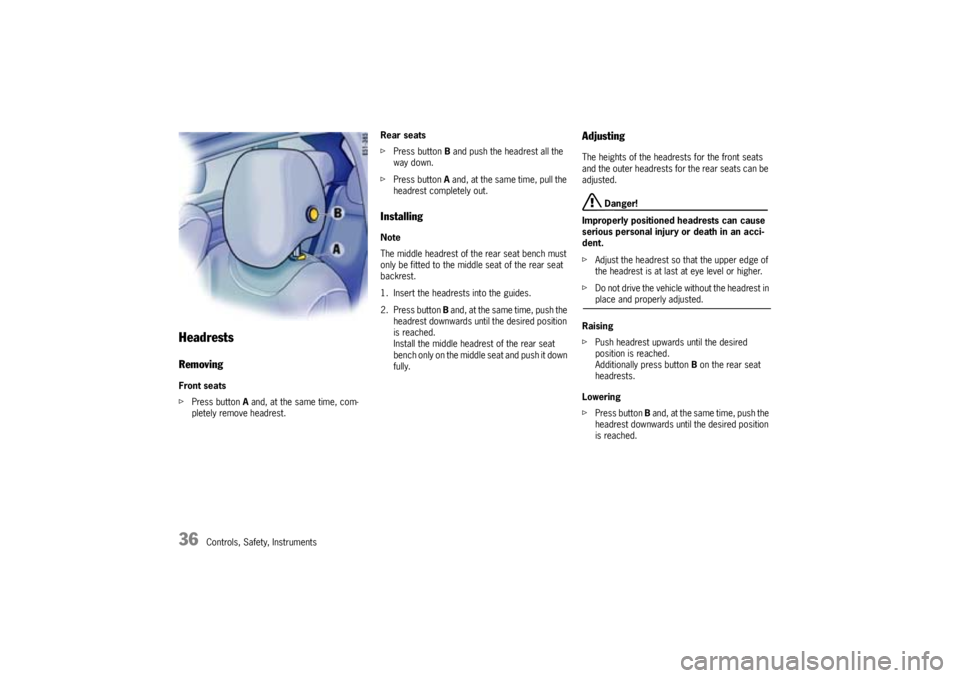
36
Controls, Safety, Instruments
HeadrestsRemovingFront seats
fPress button A and, at the same time, com-
pletely remove headrest.Rear seats
fPress button B and push the headrest all the
way down.
fPress button A and, at the same time, pull the
headrest completely out.
InstallingNote
The middle headrest of the rear seat bench must
only be fitted to the middle seat of the rear seat
backrest.
1. Insert the headrests into the guides.
2. Press button B and, at the same time, push the
headrest downwards until the desired position
is reached.
Install the middle headrest of the rear seat
bench only on the middle seat and push it down
fully.
AdjustingThe heights of the headrests for the front seats
and the outer headrests for the rear seats can be
adjusted.
Danger!
Improperly positioned headrests can cause
serious personal injury or death in an acci-
dent.
fAdjust the headrest so that the upper edge of
the headrest is at last at eye level or higher.
fDo not drive the vehicle without the headrest in place and properly adjusted.
Raising
fPush headrest upwards until the desired
position is reached.
Additionally press button B on the rear seat
headrests.
Lowering
fPress button B and, at the same time, push the
headrest downwards until the desired position
is reached.
Page 37 of 369
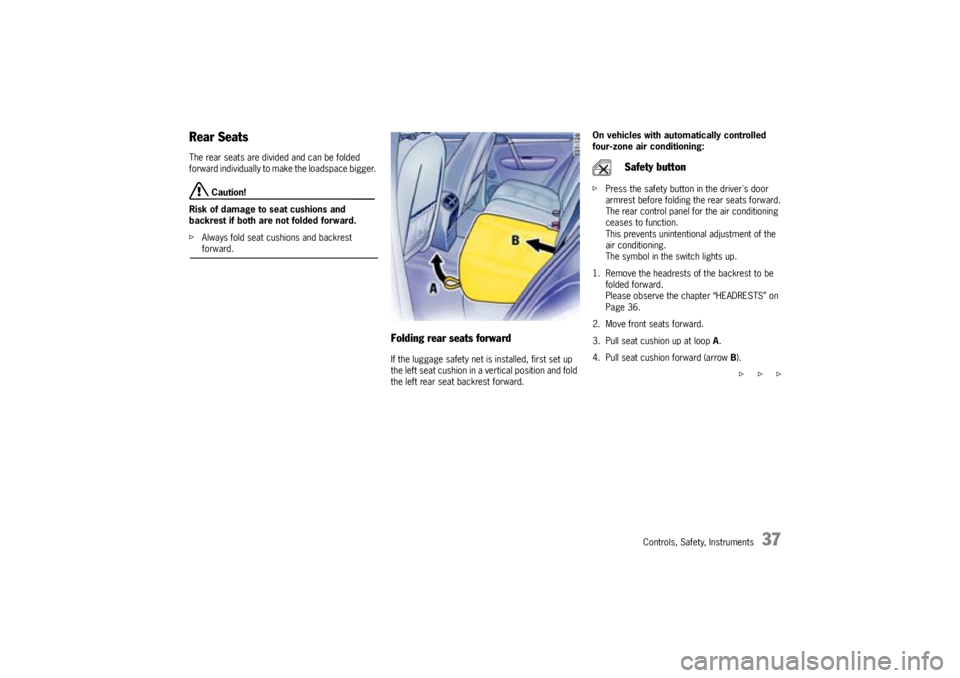
Controls, Safety, Instruments
37
Rear SeatsThe rear seats are divided and can be folded
forward individually to make the loadspace bigger.
Caution!
Risk of damage to seat cushions and
backrest if both are not folded forward.
fAlways fold seat cushions and backrest forward.
Folding rear seats forwardIf the luggage safety net is installed, first set up
the left seat cushion in a vertical position and fold
the left rear seat backrest forward.On vehicles with automatically controlled
four-zone air conditioning:
fPress the safety button in the driver's door
armrest before folding the rear seats forward.
The rear control panel for the air conditioning
ceases to function.
This prevents unintentional adjustment of the
air conditioning.
The symbol in the switch lights up.
1. Remove the headrests of the backrest to be
folded forward.
Please observe the chapter “HEADRESTS” on
Page 36.
2. Move front seats forward.
3. Pull seat cushion up at loop A.
4. Pull seat cushion forward (arrow B).
f f f
Safety button
Page 39 of 369
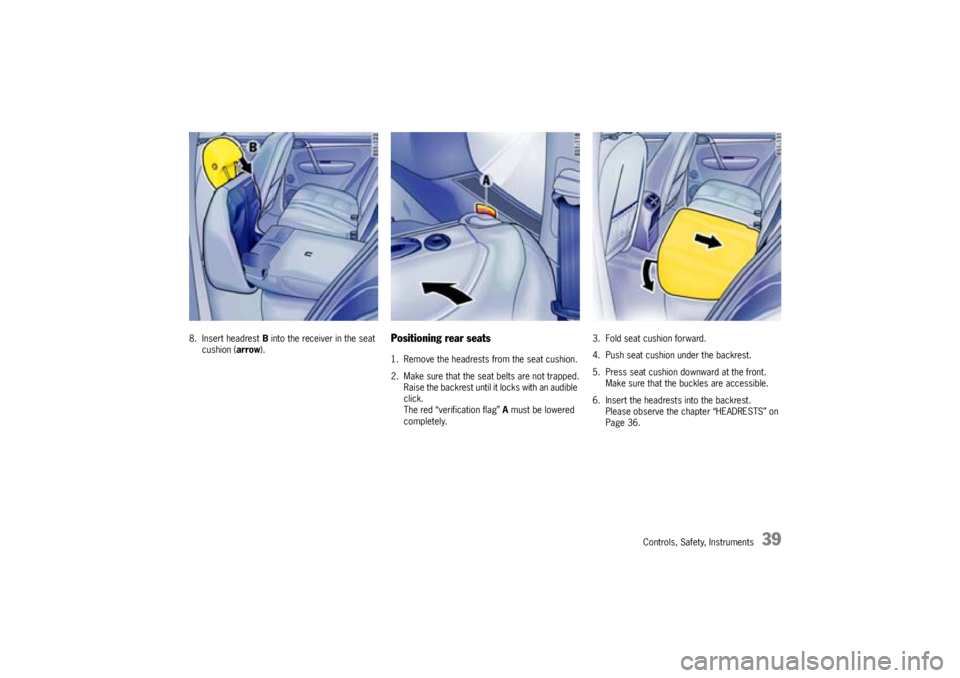
Controls, Safety, Instruments
39
8. Insert headrest B into the receiver in the seat
cushion (arrow).
Positioning rear seats1. Remove the headrests from the seat cushion.
2. Make sure that the seat belts are not trapped.
Raise the backrest until it locks with an audible
click.
The red “verification flag” A must be lowered
completely.3. Fold seat cushion forward.
4. Push seat cushion under the backrest.
5. Press seat cushion downward at the front.
Make sure that the buckles are accessible.
6. Insert the headrests into the backrest.
Please observe the chapter “HEADRESTS” on
Page 36.
Page 40 of 369
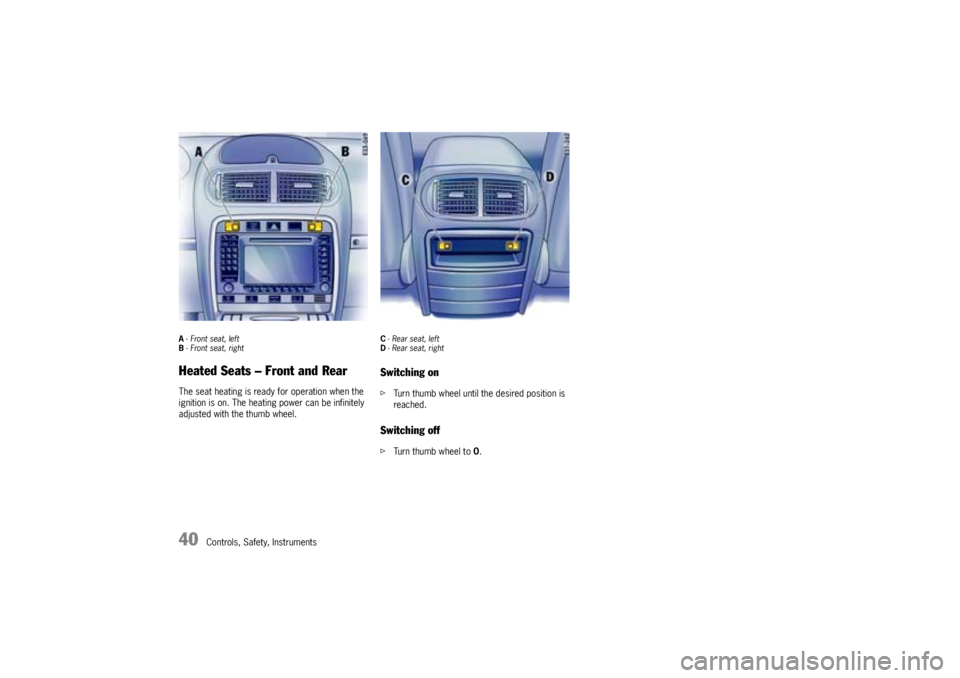
40
Controls, Safety, Instruments
A- Front seat, left
B- Front seat, rightHeated Seats – Front and RearThe seat heating is ready for operation when the
ignition is on. The heating power can be infinitely
adjusted with the thumb wheel.
C-Rear seat, left
D- Rear seat, rightSwitching onfTurn thumb wheel until the desired position is
reached.Switching offfTurn thumb wheel to 0.
Page 45 of 369
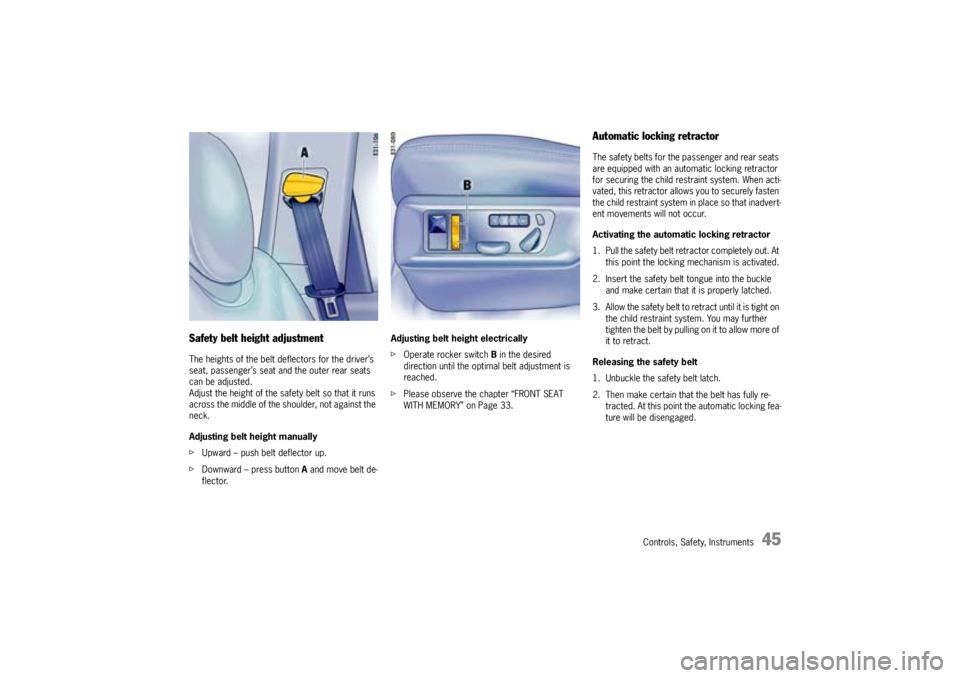
Controls, Safety, Instruments
45
Safety belt height adjustmentThe heights of the belt deflectors for the driver’s
seat, passenger’s seat and the outer rear seats
can be adjusted.
Adjust the height of the safety belt so that it runs
across the middle of the shoulder, not against the
neck.
Adjusting belt height manually
fUpward – push belt deflector up.
fDownward – press button Aand move belt de-
flector.Adjusting belt height electrically
fOperate rocker switch B in the desired
direction until the optimal belt adjustment is
reached.
fPlease observe the chapter “FRONT SEAT
WITH MEMORY” on Page 33.
Automatic locking retractorThe safety belts for the passenger and rear seats
are equipped with an automatic locking retractor
for securing the child restraint system. When acti-
vated, this retractor allows you to securely fasten
the child restraint system in place so that inadvert-
ent movements will not occur.
Activating the automatic locking retractor
1. Pull the safety belt retractor completely out. At
this point the locking mechanism is activated.
2. Insert the safety belt tongue into the buckle
and make certain that it is properly latched.
3. Allow the safety belt to retract until it is tight on
the child restraint system. You may further
tighten the belt by pulling on it to allow more of
it to retract.
Releasing the safety belt
1. Unbuckle the safety belt latch.
2. Then make certain that the belt has fully re-
tracted. At this point the automatic locking fea-
ture will be disengaged.
Page 46 of 369
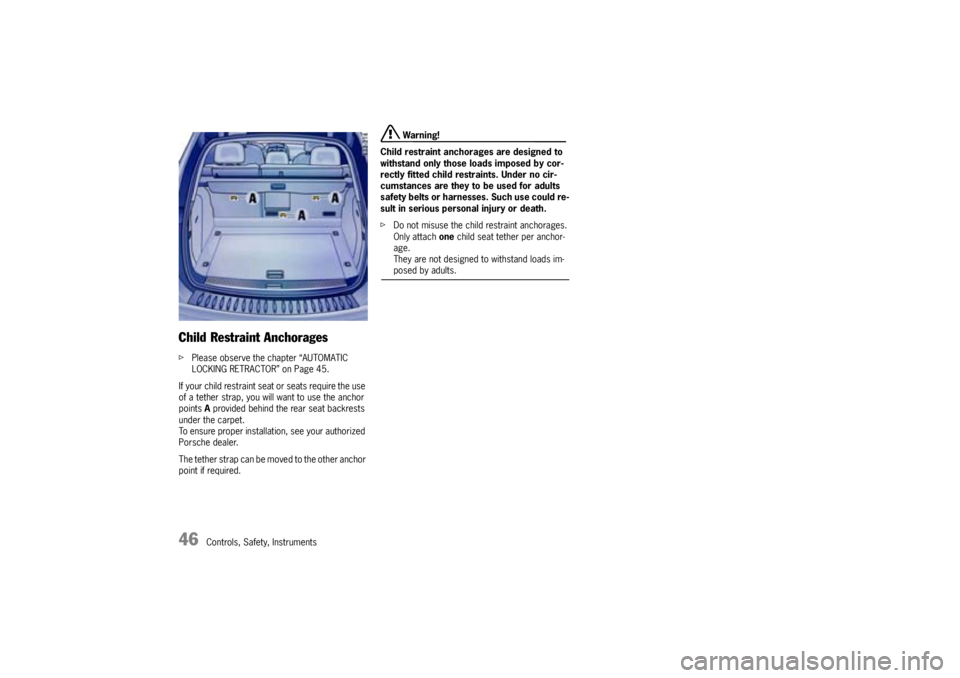
46
Controls, Safety, Instruments
Child Restraint AnchoragesfPlease observe the chapter “AUTOMATIC
LOCKING RETRACTOR” on Page 45.
If your child restraint seat or seats require the use
of a tether strap, you will want to use the anchor
pointsA provided behind the rear seat backrests
under the carpet.
To ensure proper installation, see your authorized
Porsche dealer.
The tether strap can be moved to the other anchor
point if required.
Warning!
Child restraint anchorages are designed to
withstand only those loads imposed by cor-
rectly fitted child restraints. Under no cir-
cumstances are they to be used for adults
safety belts or harnesses. Such use could re-
sult in serious personal injury or death.
fDo not misuse the child restraint anchorages.
Only attach one child seat tether per anchor-
age.
They are not designed to withstand loads im-posed by adults.
Page 47 of 369
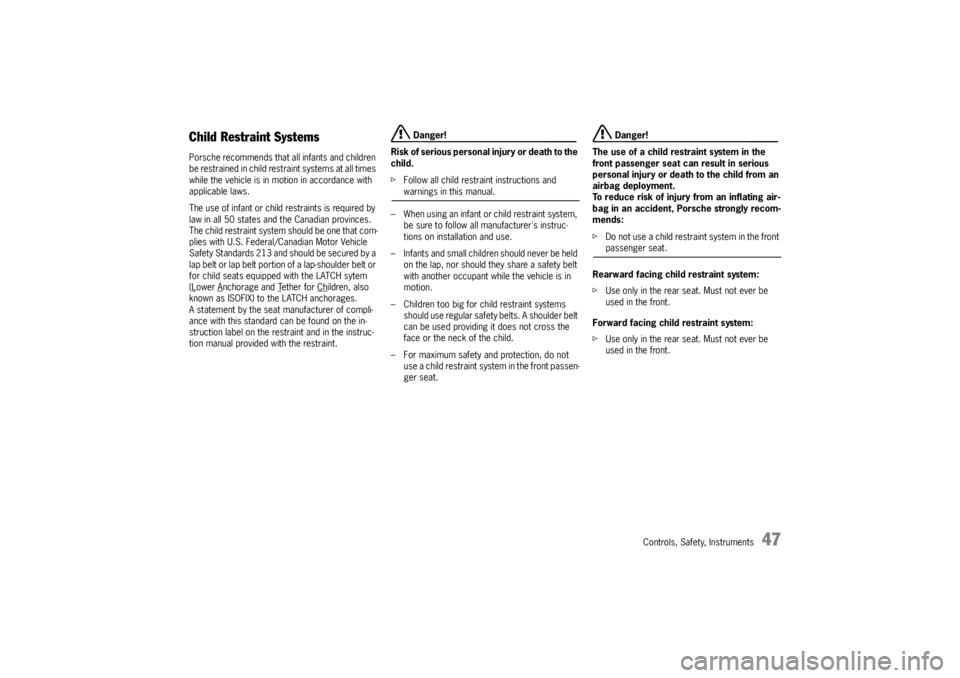
Controls, Safety, Instruments
47
Child Restraint SystemsPorsche recommends that all infants and children
be restrained in child restraint systems at all times
while the vehicle is in motion in accordance with
applicable laws.
The use of infant or child restraints is required by
law in all 50 states and the Canadian provinces.
The child restraint system should be one that com-
plies with U.S. Federal/Canadian Motor Vehicle
Safety Standards 213 and should be secured by a
lap belt or lap belt portion of a lap-shoulder belt or
for child seats equipped with the LATCH sytem
(Lower A
nchorage and T
ether for Ch
ildren, also
known as ISOFIX) to the LATCH anchorages.
A statement by the seat manufacturer of compli-
ance with this standard can be found on the in-
struction label on the restraint and in the instruc-
tion manual provided with the restraint.
Danger!
Risk of serious personal injury or death to the
child.
fFollow all child restraint instructions and warnings in this manual.
– When using an infant or child restraint system,
be sure to follow all manufacturer's instruc-
tions on installation and use.
– Infants and small children should never be held
on the lap, nor should they share a safety belt
with another occupant while the vehicle is in
motion.
– Children too big for child restraint systems
should use regular safety belts. A shoulder belt
can be used providing it does not cross the
face or the neck of the child.
– For maximum safety and protection, do not
use a child restraint system in the front passen-
ger seat.
Danger!
The use of a child restraint system in the
front passenger seat can result in serious
personal injury or death to the child from an
airbag deployment.
To reduce risk of injury from an inflating air-
bag in an accident, Porsche strongly recom-
mends:
fDo not use a child restraint system in the front passenger seat.
Rearward facing child restraint system:
fUse only in the rear seat. Must not ever be
used in the front.
Forward facing child restraint system:
fUse only in the rear seat. Must not ever be
used in the front.